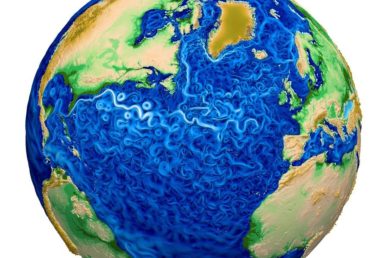E3SM Simulation Campaigns Move Forward

The E3SM project’s scientific goals address three areas of importance to earth system research: water cycle, biogeochemistry, and cryosphere. The corresponding simulation campaigns are progressing. Here’s an update on each:
Water Cycle Campaign
- High-resolution (25 km atmosphere and land, 16-8 km equator-pole ocean and sea ice) coupled water cycle simulations have now completed 30 years. The climate simulation is good, but wintertime polar surface temperature is too warm, and summertime sea ice is correspondingly low. Changes to correct these problems are being explored.
- New low-resolution (100km atmosphere/land) atmosphere-only water cycle simulations complement the already completed DECK simulations. Two three-member ensembles were conducted to compute the time-varying total effective radiative forcing (ERF) between 1870 and 2014, as well as the aerosol-cloud forcing (ERFari+aci).
Biogeochemical Campaign
- The biogeochemical (BGC) simulations make use of the lower resolution configuration (100 km atmosphere/land, 60-30 km equator-pole ocean/sea-ice). The project will make use of two different land soil BGC approaches, the Convergent Tropic Cascade (CTC) and the Equilibrium Chemistry Approximation (ECA) configurations. So far, the coupled ocean BGC and the CTC BGC have been spun-up in separate simulations and are ready to be coupled for a final phase for consistent initial conditions. Meanwhile, the ECA land spin-up has started. Production coupled BGC simulations will begin soon.
Cryosphere Campaign
- Ocean-sea-ice only simulations have been conducted for several decades at both low and high resolution (~30 and ~10 km near Antarctic ice shelves, respectively), including heat and freshwater fluxes between the ocean and ice shelves, in order to demonstrate the importance of high spatial resolution on accurate simulation of sub-ice shelf melt rates.
- One set of low-resolution pre-industrial (1850) fully coupled simulations have been conducted for about 75 years, both with and without heat and freshwater fluxes between the ice shelves and oceans, in order to better understand the broader impacts of explicitly resolved ice shelf melt fluxes on Southern Ocean high-latitude water mass transformation and regional and global ocean circulation.
- Low-resolution simulations with improved liquid and solid Antarctic ice sheet fluxes to the ocean (explicit sub-ice shelf melting and data iceberg climatology) have been conducted for about 100 years to study the importance of improved treatments compared to more approximate treatments.


